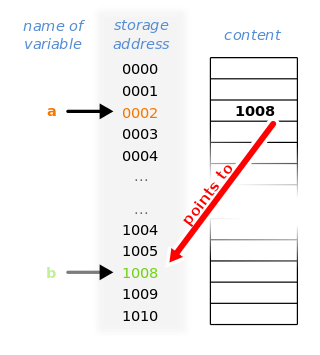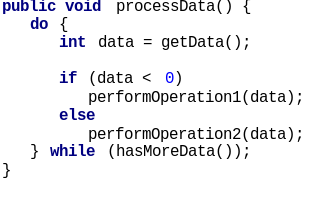Java and C++ are two prominent object-oriented programming languages. By many language popularity metrics, the two languages have dominated object-oriented and high-performance software development for much of the 21st century, and are often directly compared and contrasted. Java appeared about 10 years later and its syntax was based on C/C++.
Generic programming is a style of computer programming in which algorithms are written in terms of types to-be-specified-later that are then instantiated when needed for specific types provided as parameters. This approach, pioneered by the ML programming language in 1973, permits writing common functions or types that differ only in the set of types on which they operate when used, thus reducing duplication. Such software entities are known as generics in Ada, C#, Delphi, Eiffel, F#, Java, Nim, Python, Go, Rust, Swift, TypeScript and Visual Basic .NET. They are known as parametric polymorphism in ML, Scala, Julia, and Haskell ; templates in C++ and D; and parameterized types in the influential 1994 book Design Patterns.
In object-oriented and functional programming, an immutable object is an object whose state cannot be modified after it is created. This is in contrast to a mutable object, which can be modified after it is created. In some cases, an object is considered immutable even if some internally used attributes change, but the object's state appears unchanging from an external point of view. For example, an object that uses memoization to cache the results of expensive computations could still be considered an immutable object.
In computer programming, a type system is a logical system comprising a set of rules that assigns a property called a type to every "term". Usually the terms are various constructs of a computer program, such as variables, expressions, functions, or modules. A type system dictates the operations that can be performed on a term. For variables, the type system determines the allowed values of that term. Type systems formalize and enforce the otherwise implicit categories the programmer uses for algebraic data types, data structures, or other components.
In computer science, primitive data types are a set of basic data types from which all other data types are constructed. Specifically it often refers to the limited set of data representations in use by a particular processor, which all compiled programs must use. Most processors support a similar set of primitive data types, although the specific representations vary. More generally, "primitive data types" may refer to the standard data types built into a programming language. Data types which are not primitive are referred to as derived or composite.

In computer science, a pointer is an object in many programming languages that stores a memory address. This can be that of another value located in computer memory, or in some cases, that of memory-mapped computer hardware. A pointer references a location in memory, and obtaining the value stored at that location is known as dereferencing the pointer. As an analogy, a page number in a book's index could be considered a pointer to the corresponding page; dereferencing such a pointer would be done by flipping to the page with the given page number and reading the text found on that page. The actual format and content of a pointer variable is dependent on the underlying computer architecture.
In computer science, type conversion, type casting, type coercion, and type juggling are different ways of changing an expression from one data type to another. An example would be the conversion of an integer value into a floating point value or its textual representation as a string, and vice versa. Type conversions can take advantage of certain features of type hierarchies or data representations. Two important aspects of a type conversion are whether it happens implicitly (automatically) or explicitly, and whether the underlying data representation is converted from one representation into another, or a given representation is merely reinterpreted as the representation of another data type. In general, both primitive and compound data types can be converted.
This article compares two programming languages: C# with Java. While the focus of this article is mainly the languages and their features, such a comparison will necessarily also consider some features of platforms and libraries. For a more detailed comparison of the platforms, see Comparison of the Java and .NET platforms.

The syntax of Java refers to the set of rules defining how a Java program is written and interpreted.
In computer science, a relational operator is a programming language construct or operator that tests or defines some kind of relation between two entities. These include numerical equality and inequalities.
In computer science, string interning is a method of storing only one copy of each distinct string value, which must be immutable. Interning strings makes some string processing tasks more time- or space-efficient at the cost of requiring more time when the string is created or interned. The distinct values are stored in a string intern pool.
In some programming languages, const is a type qualifier that indicates that the data is read-only. While this can be used to declare constants, const in the C family of languages differs from similar constructs in other languages in being part of the type, and thus has complicated behavior when combined with pointers, references, composite data types, and type-checking. In other languages, the data is not in a single memory location, but copied at compile time on each use. Languages which utilize it include C, C++, D, JavaScript, Julia, and Rust.
The computer programming languages C and Pascal have similar times of origin, influences, and purposes. Both were used to design their own compilers early in their lifetimes. The original Pascal definition appeared in 1969 and a first compiler in 1970. The first version of C appeared in 1972.

C# is a general-purpose, high-level multi-paradigm programming language. C# encompasses static typing, strong typing, lexically scoped, imperative, declarative, functional, generic, object-oriented (class-based), and component-oriented programming disciplines.

Scala is a strong statically typed general-purpose programming language that supports both object-oriented programming and functional programming. Designed to be concise, many of Scala's design decisions are aimed to address criticisms of Java.
In object-oriented programming, a wrapper class is a class that encapsulates types, so that those types can be used to create object instances and methods in another class that needs those types. So a primitive wrapper class is a wrapper class that encapsulates, hides or wraps data types from the eight primitive data types, so that these can be used to create instantiated objects with methods in another class or in other classes. The primitive wrapper classes are found in the Java API.
In Microsoft's .NET Framework, the Common Type System (CTS) is a standard that specifies how type definitions and specific values of types are represented in computer memory. It is intended to allow programs written in different programming languages to easily share information. As used in programming languages, a type can be described as a definition of a set of values, and the allowable operations on those values.
Generics are a facility of generic programming that were added to the Java programming language in 2004 within version J2SE 5.0. They were designed to extend Java's type system to allow "a type or method to operate on objects of various types while providing compile-time type safety". The aspect compile-time type safety was not fully achieved, since it was shown in 2016 that it is not guaranteed in all cases.
In computer programming, a constant is a value that should not be altered by the program during normal execution, i.e., the value is constant. When associated with an identifier, a constant is said to be "named," although the terms "constant" and "named constant" are often used interchangeably. This is contrasted with a variable, which is an identifier with a value that can be changed during normal execution, i.e., the value is variable.
In computing, Java bytecode is the bytecode-structured instruction set of the Java virtual machine (JVM), a virtual machine that enables a computer to run programs written in the Java programming language and several other programming languages, see List of JVM languages.



